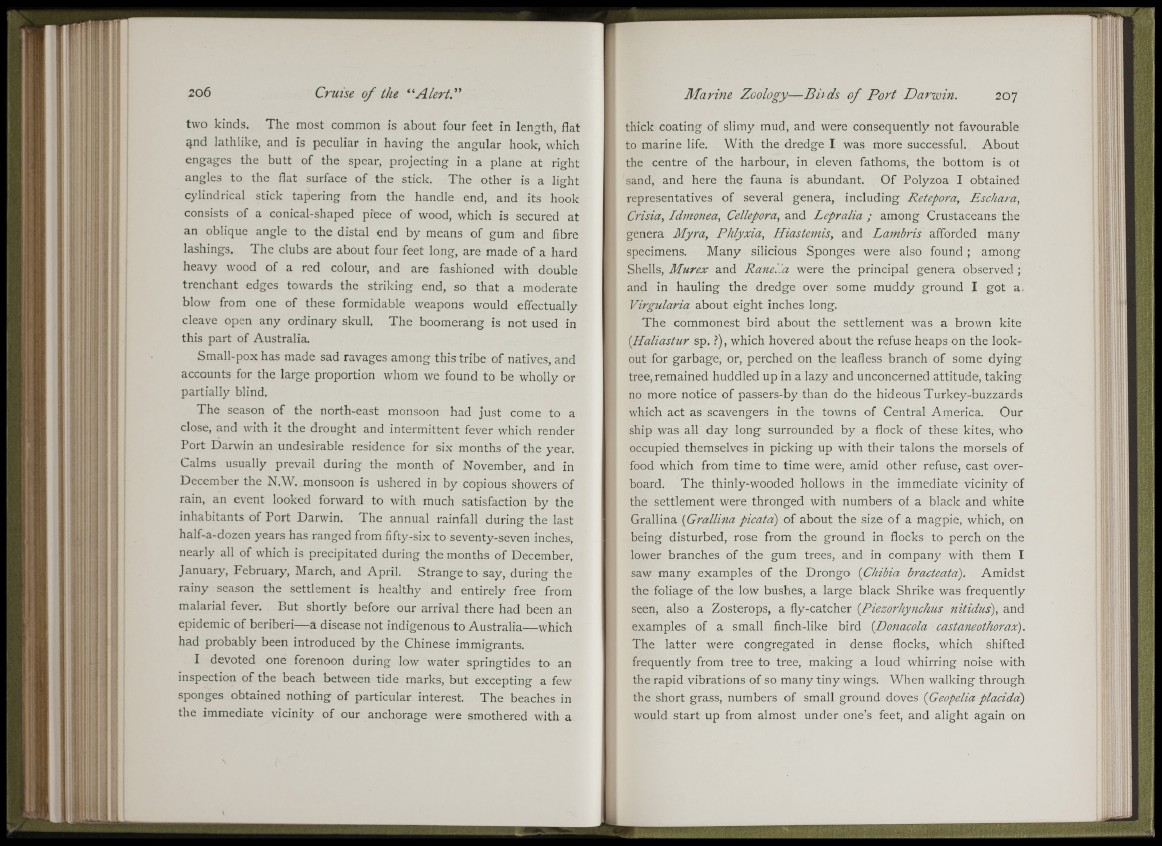
i | i
i f 4 ' J I a
i ' i i i s
Ur
l i !
two kinds. The most common is about four feet in lenMo h,* flat
and lathlike, and is peculiar in having the angular hook, which
engages the butt of the spear, projecting in a plane at right
angles to the flat surface of the stick. The other is a light
cylindrical stick tapering from the handle end, and its hook
consists of a conical-shaped piece of wood, which is secured at
an oblique angle to the distal end by means of gum and fibre
lashings. The clubs are about four feet long, are made of a hard
heavy wood of a red colour, and are fashioned with double
trenchant edges towards the striking end, so that a moderate
blow from one of these formidable weapons would effectually
cleave open any ordinary skull. The boomerang is not used in
this part of Australia.
Small-pox has made sad ravages among this tribe of natives, and
accounts for the large proportion whom we found to be wholly or
partially blind.
The season of the north-east monsoon had just come to a
close, and with it the drought and intermittent fever which render
Port Darwin an undesirable residence for six months of the year.
Calms usually prevail during the month of November, and in
December the N.W. monsoon is ushered in by copious showers of
rain, an event looked forward to with much satisfaction by the
inhabitants of Port Darwin. The annual rainfall during the last
half-a-dozen years has ranged from fifty-six to seventy-seven inches,
nearly all of which is precipitated during the months of December,
January, February, March, and April. Strange to say, during the
rainy season the settlement is healthy and entirely free from
malarial fever. But shortly before our arrival there had been an
epidemic of beriberi— a disease not indigenous to Australia— which
had probably been introduced by the Chinese immigrants.
I devoted one forenoon during low water springtides to an
inspection of the beach between tide marks, but excepting a few
sponges obtained nothing of particular interest. The beaches in
the immediate vicinity of our anchorage were smothered with a
thick coating of slimy mud, and were consequently not favourable
to marine life. With the dredge I was more successful. About
the centre of the harbour, in eleven fathoms, the bottom is ot
sand, and here the fauna is abundant. Of Polyzoa I obtained
representatives of several genera, including Retepora, Eschara,
Crisia, Idmonea, Cellepora, and Lepralia ; among Crustaceans the
genera Myra, Phlyxia, Hiastemis, and Lambris afforded many
specimens. Many silicious Sponges were also found ; among
Shells, Murex and RaneCa were the principal genera observed ;
and in hauling the dredge over some muddy ground I got a.
Virgularía about eight inches long.
The commonest bird about the settlement was a brown kite
[Haliastur sp. .?), which hovered about the refuse heaps on the lookout
for garbage, or, perched on the leafless branch of some dying
tree, remained huddled up in a lazy and unconcerned attitude, taking
no more notice of passers-by than do the hideous Turkey-buzzards
which act as scavengers in the towns of Central America. Our
ship was all day long surrounded by a flock of these kites, who
occupied themselves in picking up with their talons the morsels of
food which from time to time were, amid other refuse, cast overboard.
The thinly-wooded hollows in the immediate vicinity of
the settlement were thronged with numbers of a black and white
Grallina {Grallina picata) of about the size of a magpie, which, on
being disturbed, rose from the ground in flocks to perch on the
lower branches of the gum trees, and in company with them I
saw many examples of the Drongo {Chibia bracteata). Amidst
the foliage of the low bushes, a large black Shrike was frequently
seen, also a Zosterops, a fly-catcher {Piezorhynchus nitidus), and
examples of a small finch-like bird {Donacola castaneothorax).
The latter were congregated in dense flocks, which shifted
frequently from tree to tree, making a loud whirring noise with
the rapid vibrations of so many tiny wings. When walking through
the short grass, numbers of small ground doves {Geopelia placida)
would start up from almost under one’s feet, and alight again on
—III